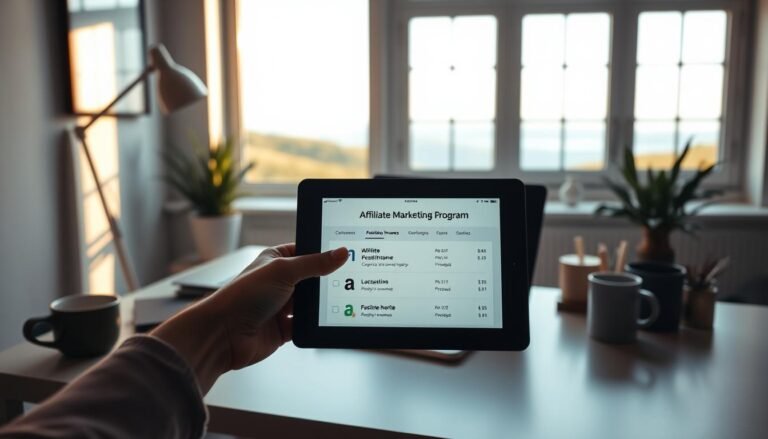How to Build a Profitable Affiliate Marketing Website

Imagine waking up every morning with the freedom to work from anywhere. You can do this while earning passive income from something you love. Affiliate marketing is a way to financial freedom, letting you promote products and services from companies through their affiliate programs.
Impact-Site-Verification: 852b6bc1-f419-4c7d-9b3d-f04796e806ca
This journey is more than just making money. It’s about building a sustainable online business that works for you. In this article, we’ll show you how to create a profitable affiliate marketing website. It can change your life.
Key Takeaways
- Affiliate marketing can enable you to earn passive income by promoting products.
- Understanding affiliate programs is essential for maximising your earnings.
- Selecting the right niche can significantly impact your success.
- Quality content is vital for engaging your audience effectively.
- Employing SEO strategies will help drive traffic to your affiliate marketing website.
Understanding Affiliate Marketing
Affiliate marketing is a new way to make money online. It lets people earn by promoting products or services from other companies. Affiliates work with merchants to bring in customers and make sales. This partnership is key in online marketing.
What is Affiliate Marketing?
Affiliate marketing is based on results. Creators or advertisers promote products from businesses. When an affiliate makes a sale or lead, they get paid. They use blogs, social media, or emails to reach customers.
The Benefits of Affiliate Marketing
There are many good things about affiliate marketing. Here are a few:
- Low startup costs: You don’t need to buy a lot of stuff, making it easy to start.
- Flexible work hours: You can work when you want, fitting it into your life.
- Passive income potential: Your marketing can keep making sales even when you’re not working.
Platforms like Amazon Associates and ClickBank have lots of programs for beginners and pros. They offer great chances in online marketing.
Choosing the Right Niche for Your Website
Finding the right niche is key to success in affiliate marketing. You should pick something you’re interested in and has market potential. This way, you’ll enjoy making content and promoting products.
Identifying Your Interests and Expertise
Start by thinking about what you love and what you’re good at. Knowing a lot about a topic makes creating content easier. Ask yourself:
- What do I enjoy discussing with others?
- What skills do I possess that can benefit my audience?
- Which subjects do I regularly seek information about?
By knowing your interests, you can find a niche that keeps you excited and connects you with others who share your passions.
Evaluating Market Demand and Competition
After picking a niche, use tools like Google Trends and Keyword Planner to check demand. These tools show how many people search for topics in your niche. It’s also important to look at the competition.
Study other affiliate sites and their strategies. Look at:
- Content quality
- Engagement on social media
- Website traffic
By understanding the competition, you can figure out how to stand out. If it’s tough, think about a sub-niche with unique content or views.
| Niche Criteria | Market Demand | Competition Level |
|---|---|---|
| Health and Wellness | High | Medium to High |
| Technology Reviews | Medium to High | High |
| Personal Finance | High | Medium |
| Travel Guides | Medium | High |
| Home Improvement | Medium | Medium |
Striking a balance between demand and competition is crucial for a strong start in affiliate marketing.
Selecting an Affiliate Program
Choosing the right affiliate program is key to your marketing success. Each program is designed for different niches and audience needs. This gives you flexibility in making money from your content. It’s important to know the types available to match your goals and preferences.
Types of Affiliate Programs Available
Affiliate programs come in several types, like pay-per-click, pay-per-sale, and pay-per-lead. Each model works differently to help you earn commissions. This is based on actions taken by the referrals you drive.
- Pay-per-click: You earn a commission based on the number of clicks generated on the affiliate link.
- Pay-per-sale: You receive a commission when a purchase is made through your link.
- Pay-per-lead: A commission is earned when a referred visitor completes a specific action, such as signing up for a newsletter or filling out a form.
Deciding on Commission Structures
Commission structures vary across different affiliate programs and networks like Rakuten and CJ Affiliate. Some offer a one-time payment per sale, while others give recurring commissions for subscription-based products. It’s important to evaluate these structures to align with your financial goals and your audience’s preferences.
When choosing an affiliate program, think about what fits your needs. Look for options that offer competitive commission rates and match your audience’s interests. Knowing these details helps you make a smart choice for a successful affiliate marketing experience.
Creating Your Website
Starting your affiliate marketing website involves making important choices. A good domain name is key, showing what your site is about. Look for a name that attracts visitors at reputable places like Namecheap or GoDaddy.
Selecting a Domain Name and Hosting Provider
First, pick a domain name that’s easy to remember and reflects your site’s content. After that, choose a hosting provider. Bluehost and SiteGround are good choices, offering great prices and important features for your site’s performance.
Choosing a Website Builder or CMS
With your domain and hosting set, pick a website builder or CMS. WordPress and Wix are great, making it easy to create a nice-looking site without coding. Focus on making your site both functional and attractive for success in affiliate marketing.
Content Creation Strategies
Creating engaging content is key for a successful affiliate marketing site. Your audience wants quality content that informs and entertains. By writing informative articles, reviews, and tutorials, you build a connection with them.
Using SEO techniques helps your content reach more people. This makes your site more visible online.
Writing High-Quality, Engaging Content
To grab your audience’s attention, create content that meets their needs and interests. Start by researching topics that fit your niche. Make your writing friendly and relatable, so readers feel connected.
Always aim for clear and concise writing. Avoid using jargon that might confuse your audience.
Incorporating Keywords for SEO Optimization
Using keywords in your content is important for SEO. Tools like Google Keyword Planner help find the right keywords for your niche. Include these keywords naturally in your writing to improve your search rankings.
But don’t overdo it. Keyword stuffing can make your content hard to read. Use keywords in titles, headings, and smoothly in the text.
Using Visuals and Multimedia
Adding visuals makes your website more appealing and keeps visitors interested. Use high-quality images, infographics, and videos to break up text. Platforms like Canva or Unsplash can help find or create great visuals.
These enhancements help reinforce your messages and boost user engagement.
Affiliate Marketing Strategies

To succeed in affiliate promotion, you need effective strategies. Try different approaches to connect with your audience and boost sales. Focus on product promotion, social media, and email marketing.
Promoting Products Effectively
Engage potential buyers with compelling product reviews and comparison articles. Use strong calls to action to push readers to buy. Show the unique features and benefits of the products to your audience.
Utilizing Social Media for Promotions
Social media like Facebook, Instagram, and Pinterest are great for reaching more people. Post content with appealing images regularly. Talk to your followers to build trust and increase sales.
Email Marketing as a Tool for Affiliate Sales
Email marketing is key for nurturing leads and driving sales. Use platforms like Mailchimp for targeted campaigns. Send personalized recommendations and exclusive content to boost engagement and sales.
Driving Traffic to Your Website
Getting people to visit your affiliate marketing site is key to success. Use both free and paid ways to get the best results. Good traffic methods can boost your site’s performance and earnings.
SEO Best Practices for Affiliate Marketing
SEO is crucial for making your site more visible online. Begin with keyword research to find the right terms for your niche. Make sure your site’s title tags, meta descriptions, and header tags have your keywords.
Getting links from trusted sites can also help. This increases your site’s authority and brings in more visitors over time.
Paid Advertising Options
Paid ads can give you quick results. Google Ads and Facebook Ads are great for targeting your audience. Remember to keep an eye on your budget to get the most value.
Check how each ad campaign is doing. This helps you see which ads work best.
| Advertising Method | Description | Benefits |
|---|---|---|
| Google Ads | Ad placement based on keyword searches | High visibility and immediate traffic |
| Facebook Ads | Targeted ads on social media platforms | Specific audience targeting and engagement |
| Content Marketing | Creating valuable content to attract visitors | Builds trust and authority, drives organic traffic |
Using these strategies can help you get more visitors and improve your affiliate marketing.
Tracking Your Progress and Earnings
![]()
To get the most out of affiliate marketing, it’s key to track your progress and earnings. Using analytics tools gives you insights into how visitors behave and convert. This helps you tweak your strategies for better results.
Using Analytics Tools to Measure Success
Google Analytics is a great tool for checking your site’s traffic, user engagement, and conversion rates. By looking at this data, you can see which content your audience likes best. This can help boost your affiliate earnings.
Metrics like bounce rate and average session duration are important. They show you where to improve, helping your online presence grow steadily.
Understanding Affiliate Commission Structures
It’s important to know how affiliate commissions work. There are different models, like pay-per-sale, pay-per-click, and pay-per-lead. Each affects your earnings differently.
For example, pay-per-sale might pay more for each sale, but pay-per-click could give you a steady income. By understanding these models, you can pick programs that fit your business goals and increase your earnings.
| Commission Structure | Definition | Potential Earnings |
|---|---|---|
| Pay-Per-Sale (PPS) | Earn a commission each time a sale is made through your referral. | High, based on the sale price. |
| Pay-Per-Click (PPC) | Earn a fee for each click generated through your links, regardless of sales. | Moderate, steady income. |
| Pay-Per-Lead (PPL) | Earn a commission based on leads generated from your referrals, such as sign-ups. | Varies, often lower than PPS but consistent. |
Conclusion
Building a profitable affiliate marketing website takes careful planning and execution. Understanding the basics of affiliate marketing helps you choose the right niche and programs. Creating high-quality content is key for keeping users engaged and earning money.
Using strategies like SEO and social media can bring more visitors to your site. This is a step toward earning passive income. Always keep an eye on your progress and be ready to change your approach as online marketing evolves.
Starting this journey requires dedication and perseverance. With these qualities, your affiliate marketing efforts can grow and become a reliable source of income over time.






2 Comments